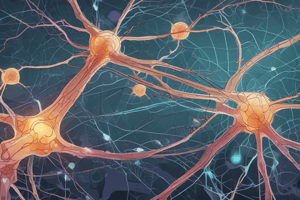Podcast
Questions and Answers
What is the direction of movement in active transport?
What is the direction of movement in active transport?
- From left to right
- From area of low concentration to area of high concentration (correct)
- From top to bottom
- From area of high concentration to area of low concentration
What is required for active transport to occur?
What is required for active transport to occur?
- Energy (correct)
- Water
- No energy
- Low energy
What is the purpose of active transport?
What is the purpose of active transport?
- To move substances from low to high concentration (correct)
- To maintain homeostasis
- To move substances from high to low concentration
- To produce energy
Which of the following is a characteristic of active transport?
Which of the following is a characteristic of active transport?
What is the opposite of active transport?
What is the opposite of active transport?
What is the basic mechanism for eliciting action potentials in nerves?
What is the basic mechanism for eliciting action potentials in nerves?
What causes a conformational change in the protein molecule that opens or closes the gate?
What causes a conformational change in the protein molecule that opens or closes the gate?
What is the result of the binding of a chemical substance with the protein channel gate?
What is the result of the binding of a chemical substance with the protein channel gate?
What type of gating is described in the text?
What type of gating is described in the text?
What is the role of the protein channel gate in nerve function?
What is the role of the protein channel gate in nerve function?
What is the term for the phenomenon where a carrier serves as an attachment point for both a sodium ion and a substance to be transported?
What is the term for the phenomenon where a carrier serves as an attachment point for both a sodium ion and a substance to be transported?
What is the role of the carrier in co-transport?
What is the role of the carrier in co-transport?
What type of transport does co-transport belong to?
What type of transport does co-transport belong to?
What is the significance of the sodium ion in co-transport?
What is the significance of the sodium ion in co-transport?
What is the result of the carrier binding to both the sodium ion and the substance to be co-transported?
What is the result of the carrier binding to both the sodium ion and the substance to be co-transported?
What is the primary reason for sodium ions attempting to diffuse into the cell?
What is the primary reason for sodium ions attempting to diffuse into the cell?
What is the direction of sodium ion movement in secondary active transport?
What is the direction of sodium ion movement in secondary active transport?
What type of transport is described in the content?
What type of transport is described in the content?
What is the term for the movement of sodium ions out of the cell?
What is the term for the movement of sodium ions out of the cell?
What is the driving force behind the movement of sodium ions in secondary active transport?
What is the driving force behind the movement of sodium ions in secondary active transport?
What is the type of transport that requires energy?
What is the type of transport that requires energy?
Which transport process involves the engulfment of solid particles?
Which transport process involves the engulfment of solid particles?
What is the term for the movement of water molecules from an area of high concentration to an area of low concentration?
What is the term for the movement of water molecules from an area of high concentration to an area of low concentration?
Which process involves the release of molecules from a cell?
Which process involves the release of molecules from a cell?
What is the term for the movement of molecules from an area of high concentration to an area of low concentration without using energy?
What is the term for the movement of molecules from an area of high concentration to an area of low concentration without using energy?
Study Notes
Mechanism of Action Potentials in Nerves
- The basic mechanism for eliciting action potentials in nerves involves chemical (ligand) gating, where protein channel gates are opened by the binding of a chemical substance, causing a conformational change in the protein molecule.
Active Transport
- Active transport is the movement of a substance from an area of low concentration to an area of high concentration, requiring energy.
- Co-transport is a form of secondary active transport, where the carrier serves as an attachment point for both the sodium ion and the substance to be co-transported.
Types of Cell Membrane Transport
- Simple diffusion: a type of passive transport
- Facilitated diffusion: a type of passive transport
- Osmosis: a type of passive transport
- Pinocytosis: a type of endocytosis
- Phagocytosis: a type of endocytosis
- Exocytosis: a type of active transport
- Primary active transport: uses a pump to transport substances
- Secondary active transport: uses a carrier to transport substances
Secondary Active Transport
- Counter-transport: sodium ions attempt to diffuse to the interior of the cell due to their large concentration gradient, and the carrier serves as an attachment point for both the sodium ion and the substance to be co-transported.
Studying That Suits You
Use AI to generate personalized quizzes and flashcards to suit your learning preferences.
Description
Explore the mechanisms behind action potentials in nerves, including chemical gating and protein channel gates. Learn how conformational changes in protein molecules open or close gates, leading to action potentials.




